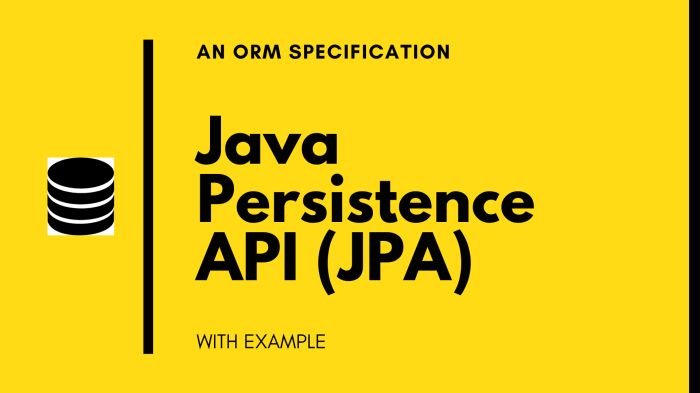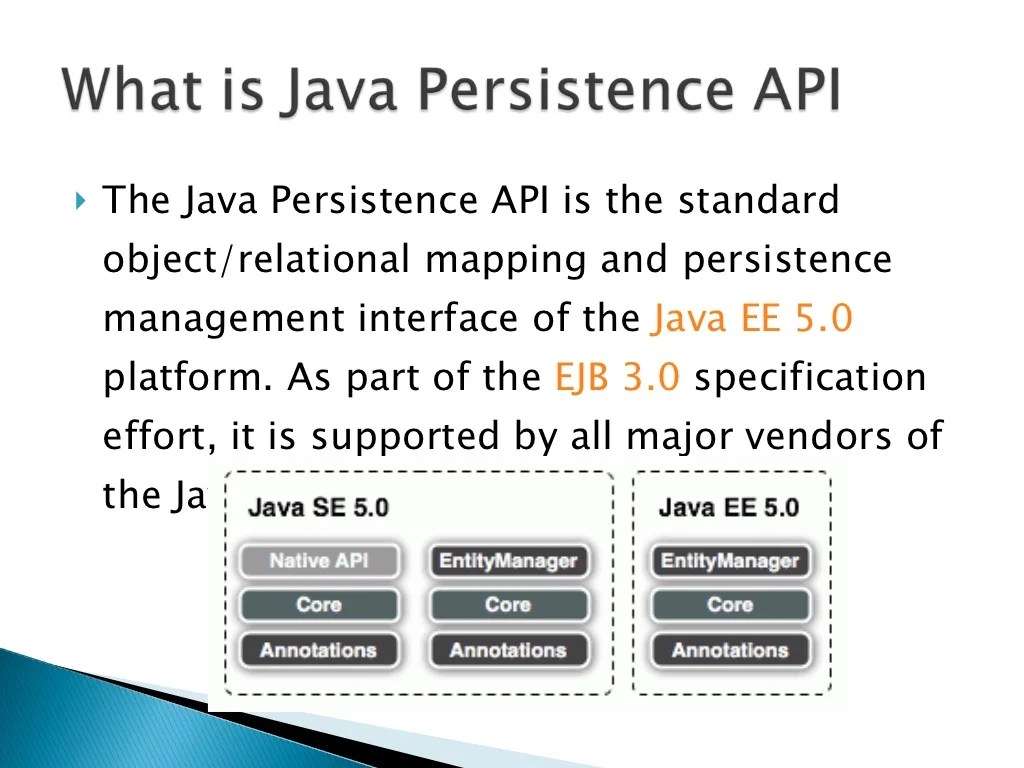Java persistence api interview questions – Java Persistence API (JPA) interview questions delve into the depths of data persistence and object-relational mapping, challenging candidates to demonstrate their understanding of this fundamental technology. This comprehensive guide equips you with the knowledge and strategies to navigate these interviews confidently, showcasing your proficiency in JPA’s core concepts and practical applications.
From entity management and mapping to queries, transactions, relationships, and performance optimization, this guide covers the full spectrum of JPA interview topics. With its clear explanations, real-world examples, and expert insights, you’ll gain the confidence to tackle even the most challenging questions and impress potential employers.
Java Persistence API

The Java Persistence API (JPA) is a specification that provides a standard way to manage data in relational databases. It simplifies the development of data-centric applications by providing a common set of interfaces and annotations that can be used to map Java objects to database tables and to perform CRUD (create, read, update, delete) operations on those objects.JPA
is based on the Entity-Relationship (ER) model, which is a conceptual model for representing data in a database. In the ER model, data is represented as entities, which are objects that have a unique identifier and a set of attributes.
Entities can be related to each other through relationships, which represent the associations between them.JPA provides a set of annotations that can be used to map Java classes to entities and relationships in the ER model. These annotations allow the JPA provider to automatically generate the SQL statements that are needed to create and manipulate the corresponding database tables and relationships.
Entity Manager

The Entity Manager is the central interface for managing entities in JPA. It provides methods for creating, reading, updating, and deleting entities, as well as for querying the database. The Entity Manager also manages the lifecycle of entities, which is the process of tracking the state of entities as they are created, modified, and deleted.The
lifecycle of an entity managed by the Entity Manager consists of the following states:*
-*New
The entity has just been created and has not yet been persisted to the database.
-
-*Managed
The entity has been persisted to the database and is being managed by the Entity Manager.
-*Detached
The entity has been removed from the Entity Manager and is no longer being managed.
-*Removed
The entity has been marked for deletion and will be deleted from the database when the Entity Manager is flushed.
The Entity Manager provides a number of methods that can be used to perform CRUD operations on entities. These methods include:*
-*persist()
Creates a new entity and persists it to the database.
-
-*merge()
Updates an existing entity and merges it with the database.
-*remove()
Deletes an entity from the database.
-*find()
Retrieves an entity from the database by its primary key.
Entity and Entity Mapping, Java persistence api interview questions
An entity is a Java class that represents a table in a database. Entities are annotated with the @Entity annotation, which specifies the name of the table that the entity represents.The process of mapping an entity to a database table involves specifying the following information:*
-*The name of the table
The name of the table that the entity represents is specified using the @Table annotation.
-
-*The primary key
The primary key of the entity is specified using the @Id annotation.
-*The columns
The columns of the entity are specified using the @Column annotation.
The following is an example of an entity mapping:“`java@Entity@Table(name = “customers”)public class Customer @Id @GeneratedValue(strategy = GenerationType.IDENTITY) private Long id; @Column(name = “first_name”) private String firstName; @Column(name = “last_name”) private String lastName; // getters and setters“`
FAQ Compilation: Java Persistence Api Interview Questions
What is the purpose of the Entity Manager in JPA?
The Entity Manager is responsible for managing the lifecycle of entities, including creating, updating, deleting, and finding entities in the database.
Explain the difference between an entity and an entity mapping.
An entity is a Java class that represents a database table, while an entity mapping defines the relationship between an entity and its corresponding table.
What are the different types of queries that can be used with JPA?
JPA supports a variety of query types, including JPQL (Java Persistence Query Language), Criteria API, and native SQL queries.
How do you manage transactions in JPA?
Transactions in JPA are managed using the EntityManager. Transactions can be started, committed, and rolled back using the appropriate methods on the EntityManager.
What are the different types of relationships that can be defined between entities?
JPA supports a variety of relationship types, including one-to-one, one-to-many, many-to-one, and many-to-many relationships.
